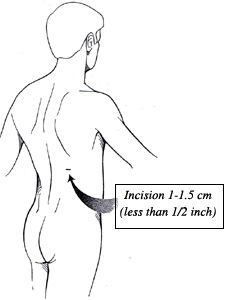Kidney stones are formed in the urinary tract due to crystallization of chemical compounds in the urine.
PCNL is a technique used to remove certain stones in the kidney or upper ureter (the tube that drains urine from the kidney to the bladder) that are too large for other forms of stone treatment such as shock wave lithotripsy or ureteroscopy.
The Surgery
This procedure has been performed on many patients over the last several years and is accepted standard of care for patients with kidney stones that are large, very firm, or resistant to other forms of stone treatment. As such it has replaced open operations for kidney stones in the vast majority of patients.
Typically, the length of the surgery is three to four hours. The surgery is performed by making a small 1 cm incision in the patient’s flank area (Figure 1). A tube is placed through the incision into the kidney under x-ray guidance. A small telescope is then passed through the tube in order to visualize the stone, break it up and remove it from the body. If necessary a laser or other device called a lithotripter may be used to break up the stone before it can be removed. This procedure has resulted in significantly less post-operative pain, a shorter hospital stay, and earlier return to work and daily activities when compared to open stone surgery.
This technique also has a higher success rate for clearing all stones in one setting than other techniques such as extracorporeal shock wave lithotripsy (ESWL), which often require several attempts.
Potential Risks and Complications
Although this procedure has proven to be very safe, as in any surgical procedure there are risks and potential complications. The safety and complication rates are similar when compared to the open surgery. Potential risks include:
- Bleeding: Some blood loss will occur with this procedure but rarely do patients require a blood transfusion. If you are interested in autologous blood transfusion (donating your own blood) you must make your surgeon aware. When the packet of information is mailed to you regarding your surgery, you will also receive an authorization form for you to take to the Red Cross. You must coordinate this with the Red Cross in your area.
- Infection: All patients are treated with broad-spectrum antibiotics to decrease the chance of infection from occurring after surgery. If you develop any signs or symptoms of infection after the surgery (fever, drainage from incision, urinary frequency or discomfort, pain or anything that you may be concerned about) please contact us at once.
- Tissue / Organ Injury: Although uncommon, possible injury to surrounding tissue/organs including bowel, vascular structures, spleen, liver, lung, pancreas and gallbladder could require further surgery. Loss of kidney function is rare but is a potential risk. Scar tissue may also form in the kidney or ureter requiring further surgery.
- Conversion to open surgery: This surgical procedure may require conversion to the standard open operation if difficulty is encountered during this procedure. This could result in a larger standard open incision and possibly a longer recuperation period.
- Failure to Remove the Stone: There is a possibility that the stone(s) may not be able to be removed completely, usually either due to the size or location of the stone(s). Additional treatment may be required.

